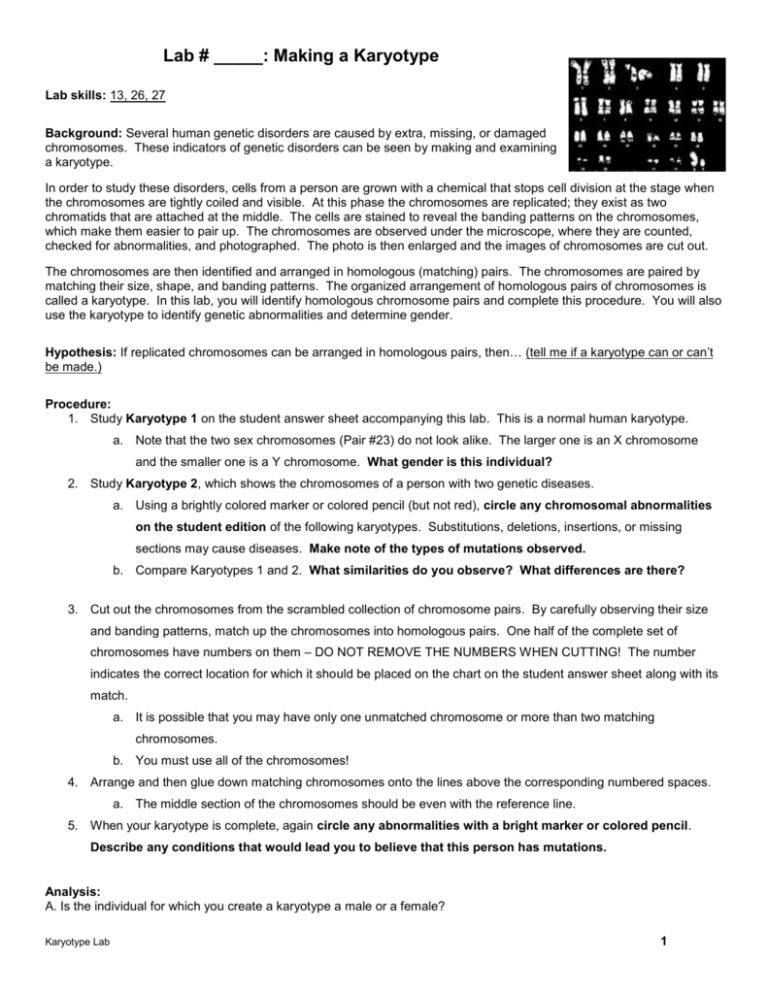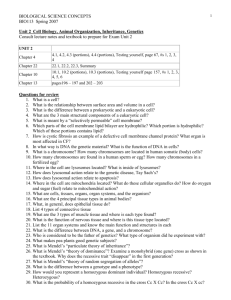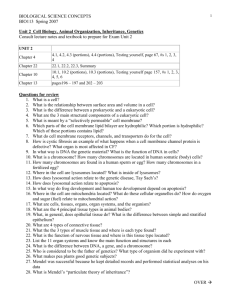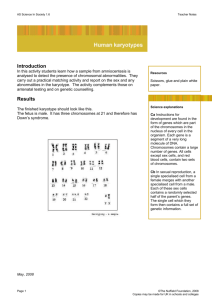Karyotype Lab: Chromosome Analysis & Genetic Disorders
advertisement

Lab # _____: Making a Karyotype Lab skills: 13, 26, 27 Background: Several human genetic disorders are caused by extra, missing, or damaged chromosomes. These indicators of genetic disorders can be seen by making and examining a karyotype. In order to study these disorders, cells from a person are grown with a chemical that stops cell division at the stage when the chromosomes are tightly coiled and visible. At this phase the chromosomes are replicated; they exist as two chromatids that are attached at the middle. The cells are stained to reveal the banding patterns on the chromosomes, which make them easier to pair up. The chromosomes are observed under the microscope, where they are counted, checked for abnormalities, and photographed. The photo is then enlarged and the images of chromosomes are cut out. The chromosomes are then identified and arranged in homologous (matching) pairs. The chromosomes are paired by matching their size, shape, and banding patterns. The organized arrangement of homologous pairs of chromosomes is called a karyotype. In this lab, you will identify homologous chromosome pairs and complete this procedure. You will also use the karyotype to identify genetic abnormalities and determine gender. Hypothesis: If replicated chromosomes can be arranged in homologous pairs, then… (tell me if a karyotype can or can’t be made.) Procedure: 1. Study Karyotype 1 on the student answer sheet accompanying this lab. This is a normal human karyotype. a. Note that the two sex chromosomes (Pair #23) do not look alike. The larger one is an X chromosome and the smaller one is a Y chromosome. What gender is this individual? 2. Study Karyotype 2, which shows the chromosomes of a person with two genetic diseases. a. Using a brightly colored marker or colored pencil (but not red), circle any chromosomal abnormalities on the student edition of the following karyotypes. Substitutions, deletions, insertions, or missing sections may cause diseases. Make note of the types of mutations observed. b. Compare Karyotypes 1 and 2. What similarities do you observe? What differences are there? 3. Cut out the chromosomes from the scrambled collection of chromosome pairs. By carefully observing their size and banding patterns, match up the chromosomes into homologous pairs. One half of the complete set of chromosomes have numbers on them – DO NOT REMOVE THE NUMBERS WHEN CUTTING! The number indicates the correct location for which it should be placed on the chart on the student answer sheet along with its match. a. It is possible that you may have only one unmatched chromosome or more than two matching chromosomes. b. You must use all of the chromosomes! 4. Arrange and then glue down matching chromosomes onto the lines above the corresponding numbered spaces. a. The middle section of the chromosomes should be even with the reference line. 5. When your karyotype is complete, again circle any abnormalities with a bright marker or colored pencil. Describe any conditions that would lead you to believe that this person has mutations. Analysis: A. Is the individual for which you create a karyotype a male or a female? Karyotype Lab 1 B. How did you determine the sex of this individual? C. When observing a karyotype, what are three clues that can be seen that would indicate the presence of a genetic disease? D. Why is it easier for a genetics laboratory worker to work with photographs of chromosomes when attempting to diagnose a disorder than the actual chromosomes? E. Why is it more difficult to construct a karyotype of unstained chromosomes? Refer to Tiger pp. 122-123 for assistance with the remaining questions… F. Chromosomes 1-22 are called autosomes. Explain how autosomes differ from the sex chromosomes (Pair #1-22) G. Genetically speaking, the disease commonly known as Down syndrome is referred to as trisomy 21. Observe the karyotype on p. 122 and examine the enlarged set of chromosomes with the abnormality. Why does the name trisomy 21 make sense? H. In a box about the size of the one shown to the right, draw what the chromosomal abnormality for Down syndrome looks like. I. Describe four traits that are common in individuals with Down syndrome. J. How frequently does Down syndrome occur in births by mothers younger than 30? K. How frequently does Down syndrome occur in births by mothers older than 45? Karyotype Lab 2 Assemble these chromosomes to create the karyotype. Karyotype Lab 3 Karyotype 1 Karyotype Lab Karyotype 2 4







